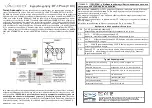
Wiring
CAUTION
Risk of Electric Shock:
Disconnect the power supply before making electrical
connections to avoid electric shock
ATTENTION
Mise En Garde: Risque de décharge électrique
Débrancher l'alimentation avant de réaliser tout rac-
cordement électrique afin d'éviter tout risque de
décharge électrique.
CAUTION
Risk of Property Damage:
Do not apply power to the system before checking all
wiring connections. Short circuited or improperly con-
nected wires may result in permanent damage to the
equipment.
ATTENTION
Mise En Garde: Risque de dégâts matériels
Ne pas mettre le système sous tension avant d'avoir
vérifié tous les raccords de câblage. Des fils for-
mant un court-circuit ou connectés de façon incor-
recte risquent d'endommager irrémédiablement
l'équipement.
Important:
Do not exceed the controller
electrical ratings. Exceeding controller electrical
ratings can result in permanent damage to the
controller and void any warranty.
Important:
Use copper conductors only. Make
all wiring in accordance with local, national, and
regional regulations.
Important:
Electrostatic discharge can
damage controller components. Use proper
electrostatic discharge precautions during
installation, setup, and servicing to avoid
damaging the controller.
For detailed information about configuring and
wiring an MS/TP bus, FC bus and SA bus, refer to
the
MS/TP Communications Bus Technical Bulletin
(LIT-12011034)
.
Network topology
FAC4911 controllers may be connected to a building
automation network in multiple ways: as daisy-
chained devices, as part of a star (also called home
run) network, or as part of a ring network.
To daisy-chain FAC4911 controllers, connect the
controllers to the bus supervisor in a chain with
the Ethernet cable connecting to the FAC4911
at the ETH1 or ETH2 port and connecting to the
next device from the other port. Benefits of daisy-
chained networks are that they require less physical
wiring and new devices can be added easily to the
network.
In a star network, each FAC4911 controller is
connected directly back to a main switch. This
configuration reduces the possibility of network
failure but requires more wiring to install.
A ring network is a chain of controllers virtually
closed by a software component in an Ethernet
switch. Not all switches support the ring topology.
The dual-port controller from Johnson Controls
supports Media Redundancy Protocol (MRP). MRP
allows a chain of Ethernet devices to overcome any
single communication failure, with a recovery time
faster than in a BACnet system.
For more information about network topologies
for the BACnet/IP Controllers, refer to the
Metasys
IP Networks for BACnet/IP Controllers Configuration
Guide Technical Bulletin (LIT-12012458)
.
Terminal blocks and bus ports
See for terminal block and bus port locations on the
controller. Observe the following guidelines when
wiring a controller.
Input and Output terminal blocks
The fixed input terminal blocks are located on the
bottom of the controller, and the output terminal
blocks are located on the top of the controller. See
Table for more information about I/O terminal
functions, requirements, and ratings.
FAC4911 Advanced Application Field Equipment Controller Installation Guide
5






































